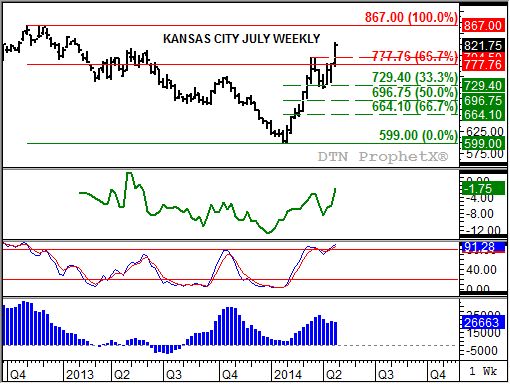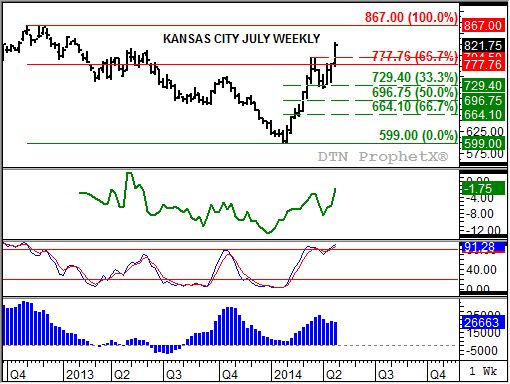Technically Speaking
Star Wars Day and July KC Wheat
Those of you who grew up in the 70's remember the cultural event that was the release of "Star Wars". Though it turned out to be Episode Four, with the first three (released decades later) introducing us to the regrettable character of Jar Jar Binks, the original movie will always be remembered for its iconic manta, "May the force be with you." So much so that middle-aged people with too much time on their hands and too few new good movies to latch on to have made May the Fourth officially "Star Wars Day" (May the Fourth be with you, get it?). Those of you not interested can consider it a warm-up to the food, drink, and festivities associated with the following day, Cinco de Mayo.
In recognition of Star Wars Day though, it seems fitting to take a look at the July Kansas City wheat contracts. What possible connection do the two have, you may ask? It's simple, not only is the HRW market now a "force" to be reckoned with, but it is so because of the harsh desert like conditions across much of the U.S. Southern Plains. These conditions bring to mind the movie's hero's home of Tatooine (An interesting fact: I was correct on the spelling of this, though Microsoft Word's spell-check disagreed), a desert planet known for unrelenting heat generated by its twin suns.
I'm sure you've seen the pictures by now of the blowing dirt across Kansas (the heart of the HRW wheat growing area), nearly burying cars stranded in roadside ditches just outside of Great Bend, Kansas. Or of countless dust storms that bring to mind the worst days of the Dirty Thirty's across this same area. It is these conditions that have provided the spark to the new-crop July Kansas City wheat contract, allowing it to easily clear its previous high of $7.77 3/4 to set its sights on the contract high of $8.67.
P[L1] D[0x0] M[300x250] OOP[F] ADUNIT[] T[]
Let's talk market structure of HRW wheat. Uptrends are usually generated by renewed noncommercial buying. But in this case, last Friday's CFTC Commitments of Traders report (positions as of Tuesday, April 29) showed this group actually reduction their net-long position by about 800 contracts (bottom study, blue histogram). Why would they do this? First, the July contract is sharply overbought with weekly stochastics approaching 90% (third study). Along with being overbought, the weekly close of $8.21 3/4 put the market in the upper 21% of its five-year price distribution range, not a welcoming invitation for new buying. And finally market volatility (not shown) has skyrocketed, finishing the week at about 23%.
So if it isn't noncommercial buying pushing the market higher, what is? The answer is simple enough: commercial interest. Notice the carry in the July to September futures spread (second study, green line) closed the week at only 1 3/4 cents. This is the narrowest this spread has been since mid-May 2013. Given the strength of the uptrend in the spread, it would not be surprising to see it move into an inverse in the near future, reflecting an increasing bullish market view of supply and demand as HRW crop prospects continue to dim.
As stated above, the upside target remains the contract high (July contract) of $8.67, a price in line with potential major resistance on the long-term monthly chart pegged at $8.63. This latter price marks the 67% retracement level of the previous major downtrend from the high of $9.90 1/2 (February 2011) through the low of $6.07 3/4 (January 2014).
If you are a Star Wars fan, and you do decide to watch all the movies today, just be sure to take a break once in a while. Maybe timing one at the 7pm (CST) open of the CME Globex session, just to see how much force the Kansas City July contract may have as we start a new week.
To track my thoughts on the markets throughout the day, follow me on Twitter: www.twitter.com\DarinNewsom






Comments
To comment, please Log In or Join our Community .